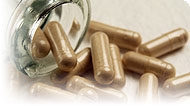Gluten Free
What does following a gluten-free diet mean? That you're embarking on an easy diet with a wide range of health-promoting effects. Instead of dwelling on what you’re giving up, consider that you’re going to enjoy a whole new world of delicious food options to meet your special dietary needs. You’ll be eating seasonally, choosing more fresh fruits and vegetables, focusing on meats, seafood, poultry, legumes, lentils, corn, and rice, and discovering fascinating ancient grains such as quinoa, amaranth, and millet. You’ll be able to eat potatoes, eggs, most cheeses, even chocolate (!)—and enjoy them without guilt because you’ll be taking good care of your body. In fact, you’ll probably end up eating—and feeling—better than ever!
Visit this page for more information about living Gluten Free
---
We carry a large variety of gluten free items, the brands listed below represent just some of the offerings we carry















More Diets
Creatine

How to Use It
Two methods are used for supplementing with creatine. In the loading method, 20 grams of creatine per day (in four divided amounts mixed well in warm liquid) are taken for five to six days.3 Muscle creatine levels increase rapidly, which is beneficial if a short-term rise in force is needed, such as during a weight-lifting competition, football game, or sprinting. To maintain muscle creatine levels after this loading period, 2–10 grams per day may be effective.4, 5
In another method, 3 grams of creatine monohydrate per day are taken over an extended training period of at least four weeks, during which muscle creatine levels rise more slowly, eventually reaching levels similar to those achieved with the loading method.6 However, no trials testing exercise performance changes have been done using this method. Taking creatine with sugar appears to maximize muscle uptake.7, 8
Caffeine intake should not be excessive, as large amounts may counteract the benefits of creatine supplementation.9
Where to Find It
Creatine is produced naturally in the human liver, pancreas, and kidneys. It is concentrated primarily in muscle tissues, including the heart. Animal proteins, including fish, are the main source of the 1–2 grams per day of dietary creatine most people consume. Supplements in the form of creatine monohydrate are well absorbed and tolerated by the stomach.
Possible Deficiencies
People involved in intense physical activity, especially those limiting their intake of red meat, may have low muscle stores of creatine. Several muscle diseases, as well as rheumatoid arthritis, and chronic circulatory and respiratory diseases, are associated with lowered creatine levels.10
Copyright © 2025 TraceGains, Inc. All rights reserved.
Learn more about TraceGains, the company.
The information presented by TraceGains is for informational purposes only. It is based on scientific studies (human, animal, or in vitro), clinical experience, or traditional usage as cited in each article. The results reported may not necessarily occur in all individuals. Self-treatment is not recommended for life-threatening conditions that require medical treatment under a doctor's care. For many of the conditions discussed, treatment with prescription or over the counter medication is also available. Consult your doctor, practitioner, and/or pharmacist for any health problem and before using any supplements or before making any changes in prescribed medications. Information expires December 2025.











